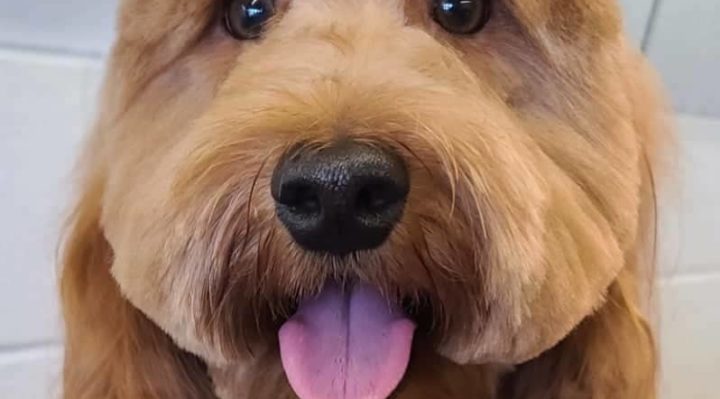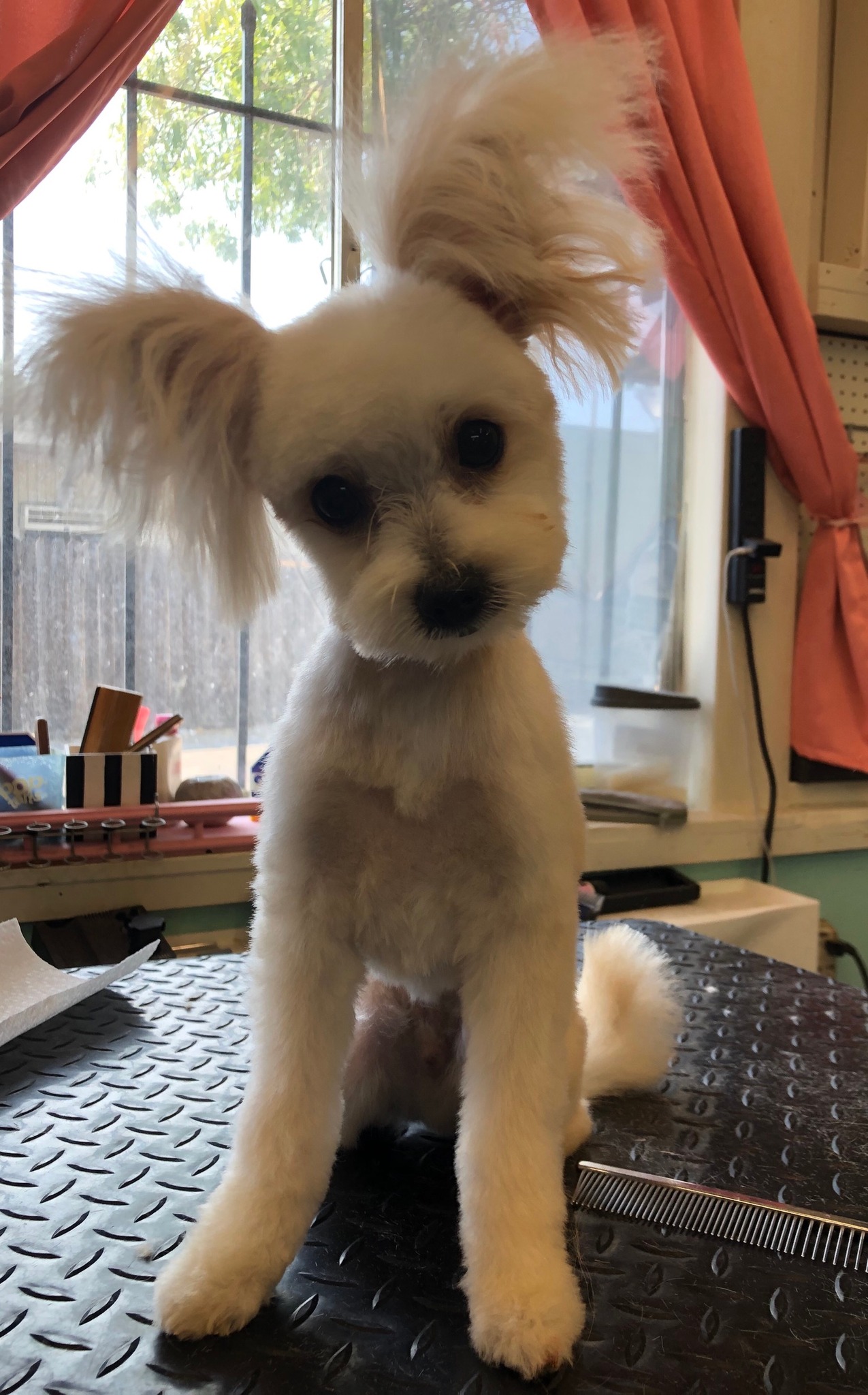
For the past three weeks, we’ve concentrated on the topic of choosing a veterinarian for your pet. This week, we’ve got suggestions on choosing a groomer. Whether it’s a short weekly visit for nail trimming by an experienced professional or a much longer monthly appointment for a full grooming with a complicated comb-out and cut completed by a true artist, many dogs, some cats, and the occasional pocket pet, bird, or lizard, may count a great groomer as part of their support team for life.
I asked several great groomers for considerations in choosing a groomer, and for their thoughts on what every animal guardian should remember to make grooming a positive part of a pet’s life.
Then, an animal lover who’s a newbie to having their pets groomed chimes in on how a great groomer can make a pet guardian’s life easier and a pet’s life more comfortable, too.
Julie Ellingson (California) Groomers can be a funny group of people. Many choose this career because they are better with animals than with people.
The biggest red flag for me [with a groomer] is employee turnover. It’s hard to get a good groomer, but a good work environment keeps good employees. I prefer that the dogs stay with their groomer—consistency is best for the dog, and we groomers get to know what is normal for that particular dog. A sudden change of disposition or new lumps are noticed right away and referred to a veterinarian for care. Constant foul odors (there’s always one person who didn’t walk their dog and a mess to clean up, but those odors are transient) and consistently cranky people [in the grooming salon] are other red flags.
I like to see relaxed dogs in crates. There are always the nervous ones, the ones who will look for their owners, but most should be calm. (One anxiously barking dog can set the whole shop off, so this, again, is a snapshot of a moment in time.) I’m not a huge fan of excess restraints and I certainly don’t like a dog being kept unnaturally tight in them. If all the dogs are “strung up,” I’d have concerns about handling or rushing. If it’s one dog, then I’ll consider it to be that individual that needs more than average.
Advice to Pet Owners
● KEEP your appointments! Many groomers are on commission and it creates havoc on their finances when you don’t.
● Train your dogs to allow handling and brushing. A running electric toothbrush is a wonderful tool to train for clipping. Ask your groomer for tips.
● Please, please, please . . have a concrete idea of how long you’d like your dog’s fur to be. “Short but not shaved” makes us tear our hair out. “1/4 inch” is better.
● Fluffy long coats are a labor of love. If you want that kind of coat, it needs to be cared for accordingly. If you cannot brush and comb the coat, have the pro do it for you at appropriate intervals. It’s not fair to the dog to always work out mats—it hurts, and the dogs learn to hate grooming for good reason. Long show coats are worked once a week at the shop, sometimes more. I have many every-other-week customers.
● Be patient. Grooming is physically taxing. You cannot rush physics: it takes time to dry a dog, and you cannot get a good groom with a damp dog. Nervous dogs need time to keep it together. Old dogs and puppies need breaks. We have to keep our clients safe, and rushing causes accidents.
For groomers, there are certificates to pursue: National Certified Master Groomer, Certified Professional Groomer, etc. There are grooming competitions. Some groomers show their dogs (or even handle professionally) in AKC or UKC shows. There is a Fear Free Groomer seminar series. Some groomers just are pet lovers with an artistic flair. Most places don’t require anything special—I learned as an apprentice 44+ years ago, and that’s still a valid way to learn. The main thing is: Are they kind? Are they honest about their comfort level and skill? Do you feel like you have a rapport?
This is an old picture of me clipping a very old dog with severe vertigo. It was not safe to pick up one leg, so my coworker is holding him while I get the underside.

Photo by Julie Ellingson
A puppy’s first groom. He was a very good boy. Which brings me to—don’t wait until your dog is a year old for a first groom! Start a puppy as soon as the shots are completed.

Photo by Julie Ellingson
A first professional bath for a different puppy. Everything we do is to make it a good experience. This puppy was actually starting to doze under the warm dryer and gentle fluffing. Nothing about this should be rushed.

Photo by Julie Ellingson
Break time sometimes means bringing out a cuddle buddy. There are perks to grooming.

Photo by Julie Ellingson
Jamie Wilke (Washington) Oh, where do I start? I’ve been in dog grooming for well over 40 years. I can say grooming is hard work, and very hard on the body. We are not miracle workers, and good groomers do the best they can to keep the dogs comfortable with as little stress as possible. Many times, that means the expectations of an owner who’s seen a photo on the internet can be disappointed, since senior dogs, puppies, or those with prior grooming trauma don’t always behave well enough for that [outcome].
I have found most doodles to be nice dogs. That can quickly change when owners do not take care of their coats and the dogs have to go through more brushing than they or I like. The doodle “breeders” tell the new owners not to shave them, yada yada. Doodles are big and hairy and are a lot of work for a groomer. The price has to reflect that. Many owners want long scissor cuts and are not happy with the $100-plus price tag that comes with that. I wish more of the doodle “breeders” would educate their buyers as to the price of the upkeep of a large hairy dog.

Photo by Jamie Wilke
As for cats, I am the only groomer in my salon who will touch them. You get one bad scratch or bite and you are out of commission. In my old age, I can pick and choose who I do. Unruly cats who have never been groomed? Those I take a hard pass on. It always surprises me how many people decide that, at 13 or 14 years of age, their cat needs to be groomed.
I also feel that new groomers coming into the profession do not realize that grooming is a hard physical job. On top of that, you have to be able to deal with poo and pee and other bodily fluids on a daily basis.
If you have an amazing groomer, tell them you appreciate them. I really feel it is a dying art.
Glenda Lee (Maine) I have always groomed Dixie myself. She’s our Great Pyrenees—a.k.a. a walking fur factory. But, due to a broken bone in my hand that wasn’t caught, and ensuing surgery to remove three bones, her coat just got completely out of hand. I took my Lab mix to a local kennel because I could not cut her nails and I also took the young cat for hers. I was so impressed with the staff that I decided to get poor Dixie groomed for the first time. We were thrilled with the results!
I’m a little tiny bit protective . . . the kennel owner is a Facebook friend and a force-free trainer. He does a lot via Facebook to improve the lives of pets and, by doing that, keeps his business as sort of top-of-mind awareness. From reading his page and a chat or two, I felt that this was a man who would have outstanding staff. I was proven right with the nail trims and again with the groomer.
I’m a do-it-myselfer, but when DIY is beyond your physical capabilities . . . Now that I’ve bitten the bullet, I’m not going to struggle with nails or anything else. Dixie obviously has to be brushed daily, but now that she’s been properly groomed, it takes minutes instead of hours. That I can do. And when she starts getting longer again, she’ll go right back!
Have you found a great groomer for your pet?
Keep your appointments and arrive on time.
Ask what you can do at home to help.
Do what your groomer suggests, regularly.
Let your groomer know they’re appreciated.
Recommend your great groomer to friends!



